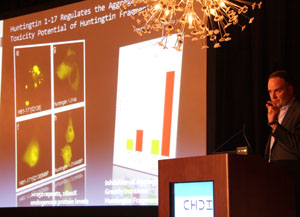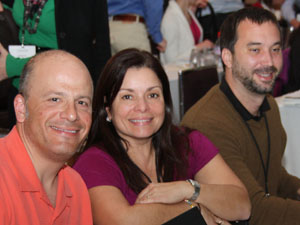
CHDI Report: Day 3
Day 3 of CHDI’s HD therapeutics conference: growth factors and CHDI’s advanced therapies

Our third and final daily report from CHDI’s annual HD therapies meeting in Palm Springs, covering chemicals that can help neurons to survive, and insights into CHDI’s most advanced experimental drug programs.
Growth factors
The final day of CHDI’s therapeutics conference began with a session devoted to growth factors. A growth factor is a chemical produced by the brain, that enables neurons to grow, remain healthy and live longer. Because of these abilities, researchers have naturally wondered whether growth factors might be able to help neurons remain healthy in people with the HD mutation.

Image credit: Gene Veritas
There are lots of different growth factors in the brain, which makes them a confusing part of HD. Not only are that, but each growth factor has distinct receptors. A receptor is molecule that ‘catches’ a signaling chemical released from another cell, triggering messages in the cell where the signal lands. Growth factors have many effects on brain cells depending on which receptor they encounter. Clive Svendsen from Cedars-Sinai in Los Angeles gave a nice overview of the different growth factors in the brain. He has previously shown that the direct infusion of one growth factor, ‘Glial cell-derived neurotrophic factor’ or ‘GDNF’, into the brains of Parkinson’s Disease patients was beneficial. These kinds of results explain why there is great excitement about being able to use growth factors as a treatment for HD.
If growth factors are so beneficial to neurons, why not just give them to everyone? Like most things in biology, the action of growth factors is in a very careful balance. Too much growth factor can lead to all kinds of problems, including memory and mood decline in mice. Moses Chao from New York University mentioned that these limitations had deterred some drug companies from working on growth factors. His lab has been trying to discover what happens after the growth factor finds its receptor. If we understood exactly how growth factors produce their beneficial effects, we might be able to try and cause those changes directly, without having to try to get extra growth factors into the brain. One chemical, adenosine, seems to mimic many of the changes in cells caused by growth factors. Gaining a better understanding of these effects might allow treatments based on growth factors with fewer side effects.
Jordi Alberch from the University of Barcelona has been studying the growth factor BDNF – brain-derived neurotrophic factor. BDNF is produced by neurons in the cortex – the wrinkly surface of the brain – which reach down into the deep brain areas that are most damaged in HD, the striatum. BDNF made in the cortex cells helps cells in the striatum to survive. We’ve known for a while that BDNF levels are lower in HD brain and that the abnormal huntingtin protein is to blame for that. Alberch’s group has been trying to figure out why BDNF behaves abnormally in HD. By recording the movement of BDNF from where it’s made to the more distant parts of cells, he’s found that BDNF can’t move freely round cells with the HD mutation. He’s also studied two different BDNF receptors. Cells with the HD mutation seem to have overactive ‘p75’ receptors and underactive ‘TrkB’ receptors, an imbalance which probably makes the cells die sooner. This work is revealing lots of possible targets for new HD treatments.
That was the perfect backdrop to Alex Kiselyov’s presentation. He’s part of the team at CHDI working to hit those targets with new drugs. He revealed the techniques CHDI is using to design drugs, based on our understanding of BDNF and its receptors TrkB and p75. The bit of TrkB that sits outside the cell resembles the wings of a phoenix, Kiselyov suggested, and the best area to target with new drugs is the place where the wings meet. It was fascinating to hear how CHDI’s chemists experiment with specially designed molecules to come up with and test drug candidates, and that this team alone is also working on at least three ‘backup plans’ in parallel, in case the first approach doesn’t work out.
“Meetings like this are an opportunity to take stock of how much has happened and the real progress that’s being made”
CHDI’s internal programs
The final session of the conference was an important one. For the first time, CHDI chose to update the scientists in attendance on their own programs. CHDI does a huge amount of work facilitating other people’s research, but they have a number of drug development programs happening internally at the company. These are the projects that they’re placing the biggest bets on. Robert Pacifici, Chief Scientific Officer, kicked off the session by giving an overview of some internal changes in how CHDI is organized. Because CHDI has grown – 54 people now work directly for the company – they’ve reorganized themselves into specific teams of researchers working on different aspects of HD. Each team has several projects that they’re trying to turn into drugs. At any time, CHDI is working full-speed on about 10 different drug development projects. For a sense of scale, that’s more programs than most large pharmaceutical companies have in all areas of brain research, including much more common diseases like Alzheimer’s or Parkinson’s disease. CHDI is changing the pace and scope of HD drug development.
With this understanding, the scientific program ended with detailed presentations on two of CHDI’s drug design efforts. Ignacio ‘Nacho’ Muñoz-Sanjuan, Vice President of biology, talked about his team’s project to inhibit a protein called ‘Kynurenine 3-monooxygenase’, or ‘KMO’. Several academic labs have noticed that the activity of this protein is increased in mouse models of HD, and they think that blocking it might help with symptoms. But designing a drug is complicated, as Muñoz-Sanjuan demonstrated. Each protein in the body is a tiny complex machine that’s built to do something very specific. Most drugs work by blocking these tiny machines in a targeted way, because if they’re not specific the drug will cause side effects by blocking other targets. To understand whether blocking KMO would be helpful for HD, CHDI has bred several new types of genetically altered mouse, looked carefully in human tissues from donated brains, and done an enormous amount of chemistry to design drugs that target it. HD mice that have less KMO improved in some ways but fared worse in others, so the picture is complex but there’s agreement that developing drugs to target KMO is still worthwhile. CHDI has several tailor-made KMO drug candidates that they are honing further before testing in HD animal models. Drug development is incredibly difficult, and failure is very common – most ideas don’t turn into drugs that work. It’s only by exhaustively testing each idea, as CHDI is doing here, that we can find out what works and what doesn’t.
The final presentation of the meeting was by CHDI’s Vice President of chemistry Celia Dominguez. As a medicinal chemist, she specializes in finding and designing drugs to hit specific targets in the body. The project she presented was looking for drugs to reduce the activity of a protein called HDAC4. There are eleven HDAC proteins and they all act to uncover the DNA in the nucleus of cells. One of the ways the abnormal huntingtin protein causes damage is by altering which genes are switched on and off, so if the activity of HDAC proteins can be reduced, the DNA will be less exposed and some of those problems might be avoided. HDAC inhibitor drugs have been shown to work in a mouse model of HD but have bad side effects. Important work by Prof. Gill Bates in London has shown that HDAC4 is the most likely of the eleven HDAC proteins to be a good target for possible HD treatments.

Image credit: Gene Veritas
Working with BioFocus, a drug development company, Dominguez has made impressive progress towards making drugs that will act on HDAC4. The first step is to understand what part of HDAC4 is active, and what the shape of that part is. Dominguez described it as a “picky pocket” because not many molecules have the right shape to fit into it. Starting with existing drugs, the team makes small changes to the structure and tests how well each new drug fits into the pocket, all the while trying to balance the risk of side effects and maximize the chance that the drug will get into the brain if given to humans. It’s a difficult process because, all too often, improving one aspect of a drug’s performance causes others to get worse. Dominguez is a determined drug-hunter, though, and she feels confident she’ll have a candidate drug by June this year, with properties desirable enough to test in an HD mouse. That optimism was a great note on which to finish the conference.
Sunset Conclusions
At the close of this conference, there was a feeling that important new research had been presented and the atmosphere had been one of unprecedented openness and collaboration. We know that, to HD-affected people, as each year passes with no effective treatments for HD, it can feel like nothing is being done at all, but meetings like this are an opportunity to take stock of how much has happened and the real progress that’s being made. Crucially, they enable scientists to make new connections and boost each other’s research.
We hope our daily updates have given you a flavor of the way science moves forward in small but important steps towards our shared goal of effective treatments. Finally, look out for our article on our interview with three of CHDI’s top scientists – coming soon.
Learn more
For more information about our disclosure policy see our FAQ…


